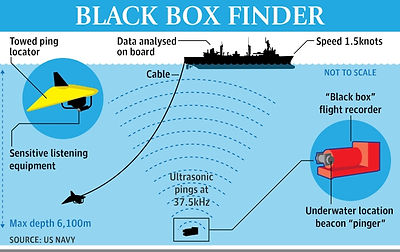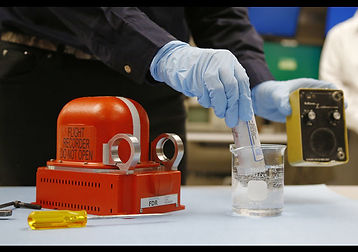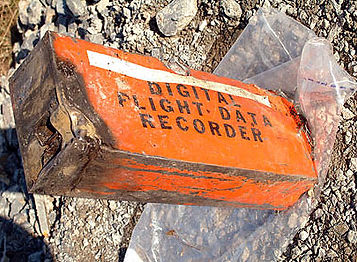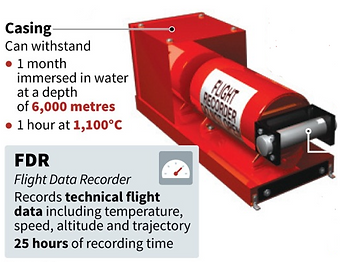
Development of Avionics Infotainment System
What Is Flight Recorder
Any commercial aeroplane or corporate jet is required to be equipped with a flight recorder which is also known as a black box. The black box consists of two different types of recorder which is Flight Data Recorder(FDR) and Cockpit Voice Recorder(CVR). The two recorders are required by international regulation to be capable of surviving the conditions likely to be encountered in a severe aircraft accident. The two recorders give a testimony, narrating the flight history with accuracy and impartiality, to assist in an investigation. Today, the Black Box is still just as vitally important in helping piece together the causes of a plane crash.




What Is Underwater Locator Beacon
An underwater acoustic beacon or which is well-known as underwater locator beacon (ULB) is a device fitted to aviation flight recorders such as the cockpit voice recorder (CVR) and flight data recorder (FDR). ULBs are triggered by water immersion which means it will send out continuous ultrasonic 10ms pulse once per second at 37.5 kHz ± 1 kHz when the water switch is in contact with fresh or salt water.
The ULB can only be detected by a receiver under the surface of the water. The maximum detection range of a ULB is typically up to 2 to 3 kilometres but is dependent on:
-
ULB acoustic output level
-
Receiver sensitivity
-
Whether the ULB is buried by debris (e.g. aircraft structure and mud)
-
The ambient noise level (e.g. sea state, nearby boats, marine animals, gas and oil lines)
-
Water temperature gradients
-
Depth difference between the ULB and the receiver



Flight Data Recorder (FDR)
A flight data recorder (FDR) (also ADR, for accident data recorder) is an electronic device employed to record any instructions sent to any electronic systems on an aircraft. It is a device used to record specific aircraft performance parameters. This piece of equipment is essential to the work of Air Crash Investigators as it records the many different operating functions of a plane all at once, such as the time, altitude, airspeed and direction the plane is heading. But these are just the primary functions of the recorder, in fact, modern Flight Data Recorders are able to monitor countless other actions undertaken by the plane, such as the movement of individual flaps on the wings, auto-pilot and fuel gauge. The exterior of the FDR is coated with heat-resistant bright orange paint for high visibility in wreckage, and the unit is usually mounted in the aircraft's empennage (tail section), where it is more likely to survive a severe crash.
Below are some recording requirements For FDR:
-
Flight Path and Speed
-
Altitude & Airspeed
-
Outside Air Temperature(OAT) or Total Air Temperature (TAT)
-
Ground speed & Wind direction
-
Aircraft Altitude
-
Roll , Pitch & Yaw
-
AOA
-
Engine Power
-
Throttle level & settings
-
Engine parameters
-
Aircraft Configuration
-
Positions of all primary & secondary control surfaces
-
Electrical settings / Landing gear / Fuel & hydraulic system
-
Operation Of Aircraft
-
Pilot inputs for flight controls, radio navigation & autopilot
-
Display selection
-
Warnings (systems, ice detection, engine vibration, etc)



Cockpit Voice Recorder (CVR)
The Cockpit Voice Recorder is extremely important for determining the timing of events as it contains information of recorded audio environment in the flight deck of an aircraft such as communication between the crew and ground control and other aircraft. Investigators might be interested in any witty banter between pilots that went on just before an explosion or plane malfunction. The CVR is typically mounted in the rear of the airplane fuselage like FDR. A standard CVR is capable of recording 4 channels of audio data for a period of 2 hours.
Below are some recording requirements For CVR:
-
Audio Recording
-
Voice communication transmitted from or received by radios
-
Aural environment on the flight deck
-
Voice communication of flight crew members on the flight deck using the aircraft interphone system
-
Voice or audio signals identifying navigation or approach aids introduced in the headset or speaker
-
Voice communication of flight crew members using the passenger address system
-
Recording at least 4 tracks
-
Track 1 : Co-pilot headphones and live boom microphone
-
Track 2 : Pilot headphones and live boom microphone
-
Track 3 : Cockpit area microphone
-
Track 4 : Time reference plus the third and fourth crew members' headphone and live microphone,if applicable

